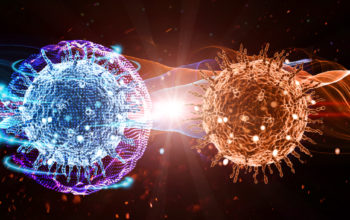
Date: 24th June 2020
Article in brief:
The current COVID-19 pandemic has caused a severe global public health crisis. As such scientists have mobilised in extraordinary ways in attempts to find rapid and effective drugs, vaccines and diagnostics. Now scientists have developed cellular nanosponges as an effective medical countermeasure to SARS-CoV-2 which can attract and neutralise the virus in vitro.
SARS-CoV-2 is novel virus and as such innovative approaches to drug development are being employed in the fight against the pandemic. One such novel approach, places the focus on the affected host cells rather than the causative agent - as is more common with traditional strategies. Nanosponges (NS) were inspired by the infectivity of SARS-CoV-2 which is known to rely on binding with protein receptors on the host cells. A team of engineers from the University of California, and researchers at Boston University, US, have developed the nanosponges with human-cell-derived membranes, sourced from cells that are naturally targeted by SARS-CoV-2.
The nanosponges were constructed by wrapping polymeric nanoparticle (NP) cores with target cell membranes. These membranes were derived from lung epithelial cells and macrophages. The resulting nanosponges, Epithelial-NS and MΦ-NS, were then used as decoys to bind with SARS-CoV-2, thereby sequestering them away from host cells.
To evaluate their toxicity the NS were administered in to the trachea of mice, 3 days later lung tissue and blood markers were examined for signs of toxicity. Both showed that minimal immune filtration and toxicity occurred, with treated mice baselines comparable to those of the control animals.
Next the team evaluated the SARS-CoV-2 neutralisation potential of the NS using a plaque reduction neutralisation test - a commonly used in vitro method to quantify the titre of a neutralising molecule for a virus. The Epithelial-NS inhibited 93% of the viral infectivity of SARS-CoV-2, with MΦ-NS showing slightly lower levels – blocking 88% of viral infectivity. Control NS coated in red blood cell membranes were not effective in neutralising SARS-CoV-2 infection.
These data suggested that nanosponges may provide a safe and efficient way to hijack viruses away from their intended target, causing them to lose the ability to infect the host cells and reproduce.
Conclusions and future applications:
This study demonstrated an exciting and novel way to fight COVID-19, creating a biomimetic nanosponge to neutralise SARS-CoV-2. Whilst this is still early days, the initial data is encouraging, and the team are working hard to test the system in animal models, paving the way for future clinical trials.
Whilst, both NS were efficient at neutralising SARS-CoV-2 it is thought that the MΦ-NS may offer added advantages. As they are derived from immune cells - these membranes may also be able to sequester inflammatory cytokines, which cause many of the most lethal manifestations of COVID-19.
As a potential therapeutic it is hoped that this treatment could be administered by aerosol, advances in this type of delivery have been seen recently for CRISPR.
Of course, the nanosponge is not just restricted to treating COVID-19, the system can be used for a wide variety of applications. Other cell membranes can be biohijacked, such that the system can be used for other viral infections, or can even be used to deliver drugs to sites of infection. The authors are currently exploring many avenues.
Biohijacking is becoming an emerging tool for therapeutic-driven research and for developing drug delivery systems. Macrophages are a natural targets to biohijack and we have reported several such developments in this arena, however there is now an expansion into more exploratory research such as repurposing tumour cancer membranes to encase oncolytic viruses, or coupling bacterial injection systems with light-controlled molecular switches enabling the delivery of cargo proteins into eukaryotic cells. The work described here further supports this exciting area of research, lending weight to its credibility and variety of applications.
Whilst, this pandemic may have to rely on other solutions, the nanosponge team are working hard to ensure this tech arrives quickly and safely to the clinic. Indeed, the joint last author of this work, Liangfang Zhang, is currently testing nanosponges cloaked with red blood cell membranes for the treatment of methicillin-resistant staphylococcus aureus (MRSA) pneumonia. Zhang’s start-up company, Cellics Therapeutics, is currently in the process of submitting an investigational new drug application to the FDA. They hope to treat the first patient next year.
It is an exciting time for this tech and it is marching quickly towards the clinic.
For more information please see the press release from the University of California
Zhang, Q., A. Honko, J. Zhou, H. Gong, S. N. Downs, J. H. Vasquez, R. H. Fang, W. Gao, A. Griffiths and L. Zhang (2020). “Cellular Nanosponges Inhibit SARS-CoV-2 Infectivity.” Nano Letters.
https://doi.org/10.1021/acs.nanolett.0c02278

